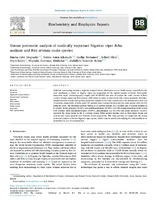Venom proteomic analysis of medically important Nigerian viper Echis ocellatus and Bitis arietans snake species
Date
2021Author
Dingwoke, Emeka John
Adamude, Fatima Amin
Klein, Ashwil
Metadata
Show full item recordAbstract
Snakebite envenoming remains a neglected tropical disease which poses severe health hazard, especially for the
rural inhabitants in Africa. In Nigeria, vipers are responsible for the highest number of deaths. Hydrophilic
interaction liquid chromatography coupled with LC-MS/MS was used to analyze the crude venoms of Echis
ocellatus (Carpet viper) and Bitis arietans (Puff adder) in order to understand their venom proteomic identities.
Results obtained revealed that gel-free proteomic analysis of the crude venoms led to the identification of 85 and
79 proteins, respectively. Seventy-eight (78) proteins were common between the two snake species with a 91.8%
similarity score. The identified proteins belong to 18 protein families in E. ocellatus and 14 protein families in
B. arietans. Serine proteases (22.31%) and metalloproteinases (21.06%) were the dominant proteins in the venom
of B. arietans; while metalloproteinases (34.84%), phospholipase A2s (21.19%) and serine proteases (15.50%)
represent the major toxins in the E. ocellatus venom. Other protein families such as three-finger toxins and
cysteine-rich venom proteins were detected in low proportions. This study provides an insight into the venom
proteomic analysis of the two Nigerian viper species, which could be useful in identifying the toxin families to be
neutralized in case of envenomation.

